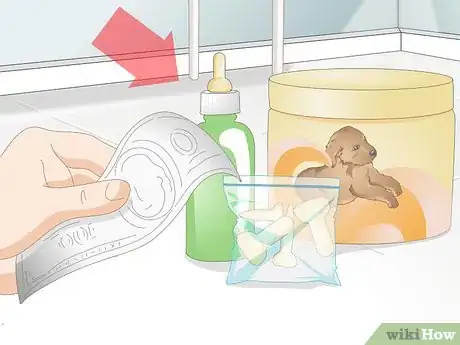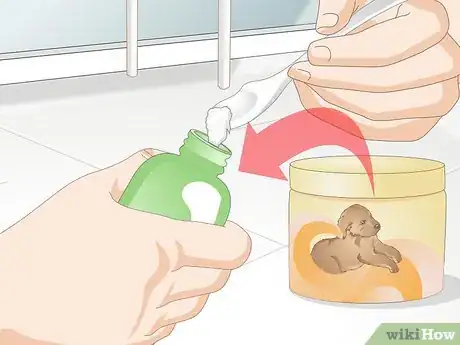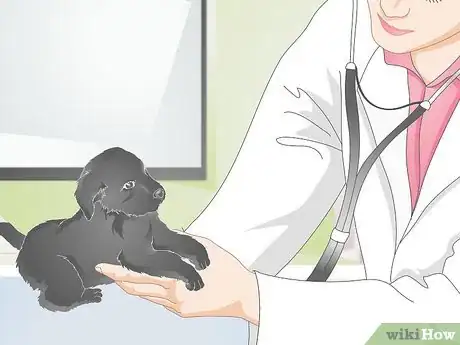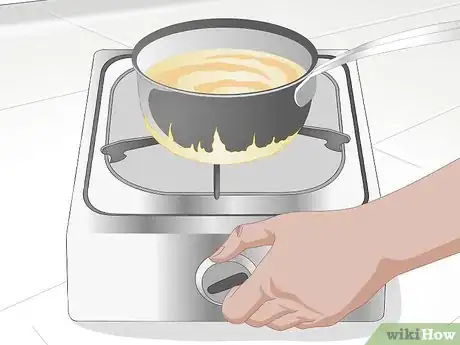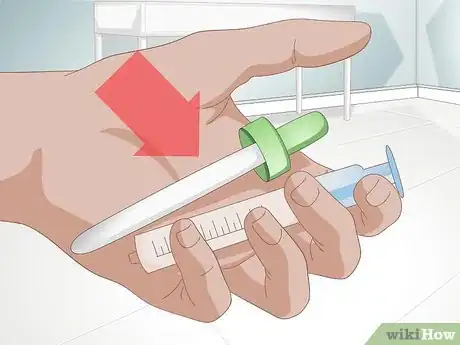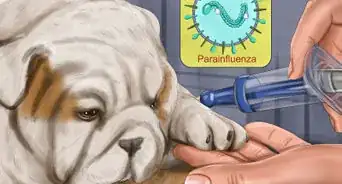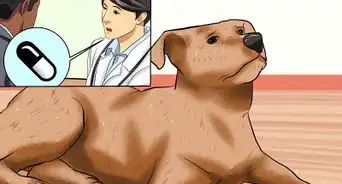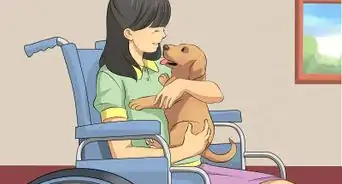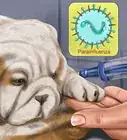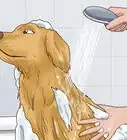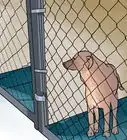This article was co-authored by Lauren Baker, DVM, PhD. Dr. Lauren Baker is a Veterinarian and Assistant Scientist at the University of Wisconsin-Madison. With over 10 years in veterinary medicine, she specializes in the concept of “one health,” which uses insights from veterinary medicine to help human medical research. She holds a Ph.D. in Comparative Biomedical Sciences, a Doctor of Veterinary Medicine, an MS in Comparative Biomedical Sciences, and a Bachelor’s degree in Psychology from the University of Wisconsin-Madison.
This article has been viewed 19,784 times.
Most puppies stay with their mothers until they are at least eight weeks old. This allows them to get old enough to start eating solid foods before they stop nursing. However, if a puppy is orphaned, it will need to be bottle fed until it is old enough to eat solid foods. Feeding an orphaned newborn puppy requires a lot of time and the right supplies, including bottles made for puppies and milk replacement made for puppies. If you need to feed a newborn puppy you will have to get the right supplies, do some calculations to figure out how much milk it needs to eat, take the time to feed it every few hours, and watch for signs that it is, or isn't, getting enough to eat.
Steps
Preparing Milk Replacement
-
1Buy necessary supplies.[1] To feed a newborn puppy you will need a bottle made specially for feeding newborn puppies and milk replacement formula. The bottle and formula can both be purchased at most large pet supply stores or online.
- You will also need to be able to sterilize the bottle. This means that you will need access to a pan and a stove to heat water on.
-
2Clean and sterilize the equipment.[2] If you buy a bottle that is made to feed newborn puppies, it should have sterilizing instructions on the packaging. However, if you do not have any instructions, be sure to clean the bottle thoroughly and then rinse it to make sure all soap residue is completely gone. Then place all pieces of the bottle into boiling water for a few minutes to sterilize them.
- It only takes a few minutes to sterilize a bottle. You do not need to sterilize the bottle for more than five minutes.
Advertisement -
3Calculate how much to feed the puppy. The amount of milk replacement that you give to the puppy depends on its weight and its age. The package that the replacement comes in should have suggested amounts for the age and weight of the puppy. However, typically a newborn puppy will eat one ounce of formula for every half pound (8 oz.) of weight over a 24 hour period. This means that if your puppy weighs one pound, it will only eat two ounces of formula spread out over the day.[3]
- The amount your dog will need to eat in a 24 hour period will need to be divided by the number of feedings you plan on giving it.
- Calculating how much food to feed the puppy before you prepare the formula is important because you should only make enough food to feed to the puppy for one day. This will assure that the milk does not ferment or go bad and cause health problems for the puppy.[4]
-
4Prepare the milk replacement.[5] Follow the directions on the packaging that the replacement came in. This usually entails adding a set amount of formula to a set amount of water and stirring.[6]
- Depending on the formula that you have bought, it may also suggest heating the water to a certain temperature before adding in the formula powder.
Feeding the Puppy
-
1Weigh the puppy. In order to assess whether your puppy is getting enough food, you should weigh it before every feeding. In general, it should be gaining ten percent of its body weight every day. This repeated weighing also helps you to gauge whether you are feeding the puppy the right amount of food.[7]
- The amount of milk replacement you feed your puppy depends on its weight. If it is quickly gaining weight then you will need to adjust the amount you are feeding it. Consult the directions on the packaging for specific amounts.
-
2Keep the puppy's head level while feeding it. One of the most important things to remember when feeding a puppy is to try and keep the milk out of its lungs. Newborn puppies are not developed enough to keep things they are eating from going into their lungs if their heads are tilted up.[8]
- Keep your puppy's body horizontal while feeding, but let it remain in a natural position. Don’t put it on its back, as you would with a human newborn.
- When you put the bottle nipple into its mouth, you should keep the bottle horizontal as well. This assures that the puppy does not lift its head while feeding.
- While feeding, you will probably not be able to tell if the dog is getting milk into its lungs because a small puppy's gag reflex is not well developed at birth.
-
3Burp the puppy after each feeding. Just like human babies, puppies need to be burped after they are fed. Hold the puppy upright and place it against your shoulder. Then pat the puppy's back lightly in order to help it release any gas that has built up in its system.[9]
- If a puppy is not burped it can become very uncomfortable and it can even be in pain due to the buildup of gas in its system.
-
4Help the puppy defecate after feeding. Infant puppies aren’t able to urinate or defecate on their own, so a mother dog will stimulate the puppy to do so with her tongue. To do this yourself, use a moist cotton ball to gently rub the puppy’s genital and anal area.[10]
- This is a good time to inspect the urine and feces to make sure it looks normal. A puppy’s stool should be soft but not watery. Keep an eye out for signs of diarrhea as well.
-
5Look for signs the puppy is getting too much food. If your puppy is getting diarrhea then it may be getting fed too much food. At the first sign of diarrhea, try reducing the amount of food you are feeding it slightly and see if that clears up the condition.[11]
- A newborn puppy with diarrhea can get severely dehydrated quickly. If the diarrhea continues for more than a day, then you should get the puppy looked at by a veterinarian.
-
6Feed a newborn puppy every two hours. Very young puppies need to eat many times each day. This can be a lot of work, especially if the puppy is very, very young. However, it is essential to the proper development of the puppy.[12]
- A newborn puppy needs to be fed twelve times a day. This means every two hours, even at night.
- A puppy that is one week old should be fed eight to ten times a day.
- A four week old puppy should be fed four times a day.
-
7Get the puppy checked out by a veterinarian. To assure that the puppy is gaining enough weight, and to assure that it is otherwise healthy, you should get it assessed by a veterinarian. The veterinarian will likely ask you a variety of questions about how you have been caring for the orphaned puppy and they will also complete a physical examination.
- If you have any specific questions about how to care for the puppy going forward, this is a good time to ask those questions.
Feeding in an Emergency
-
1Make emergency puppy milk replacement. If you cannot get commercial milk replacement immediately, then you can make a replacement with household items. Remember, however, that this mixture should only be used in an emergency, as it does not have the complete nutrition that a newborn puppy needs. To make the emergency puppy milk replacement mix together:
- 1 cup of whole milk (cow or goat)
- 1 tablespoon oil
- 1 pinch of salt
- 3 egg yolks (no whites)
-
2Warm the milk. Puppies that have just been born may need the milk they drink warmed a bit. Just as with commercial milk replacement, this emergency milk replacement should be warmed to 95 to 100 degrees. This will help to encourage that the puppy drinks it.[13]
- Be careful to heat it slowly and do not overheat it. The yolks will cook if it is heated to quickly or heated too much.
- If you warm the milk in the microwave, do it in short increments (5-10 seconds) and stir it several times while heating. This will reduce the risk of hot spots.
- Be sure to test the temperature of the milk before giving it to the puppy. Very hot milk could seriously injure a newborn puppy.
-
3Use supplies from around the house. If you don't have a bottle specifically designed to feed a newborn puppy, then you may have to use items from your home temporarily. If you have a medicine dropper or syringe that can be cleaned and sterilized, then you can try to use that. If you don't have a dropper or syringe, then you will have to use a little spoon.[14]
- Feeding a newborn puppy with a bottle designed for it will be much, much easier than using a dropper or a spoon. If you have the ability to go get a bottle at your local pet store, do it.
-
4Switch to commercial milk replacement as soon as possible. Emergency milk replacement cannot fulfill all of the puppy's nutritional needs as it grows. Commercial products are specially formulated to give the puppy the wide variety of vitamins and nutrients that are present in a mother dog's milk.[15]
- While the emergency replacement can keep a newborn puppy alive in an emergency, it can be detrimental to a dog's growth if used for too long. Only use the emergency milk replacement for a few days while you work to obtain the commercial product.[16]
References
- ↑ http://www.banfield.com/pet-health-resources/preventive-care/nutrition/nutritional-care-for-orphaned-puppies-and-kittens
- ↑ http://www.banfield.com/pet-health-resources/preventive-care/nutrition/nutritional-care-for-orphaned-puppies-and-kittens
- ↑ http://www.banfield.com/pet-health-resources/preventive-care/nutrition/nutritional-care-for-orphaned-puppies-and-kittens
- ↑ http://www.peteducation.com/article.cfm?c=2+2099&aid=863
- ↑ http://www.banfield.com/pet-health-resources/preventive-care/nutrition/nutritional-care-for-orphaned-puppies-and-kittens
- ↑ http://www.banfield.com/pet-health-resources/preventive-care/nutrition/nutritional-care-for-orphaned-puppies-and-kittens
- ↑ http://www.banfield.com/pet-health-resources/preventive-care/nutrition/nutritional-care-for-orphaned-puppies-and-kittens
- ↑ http://www.vcahospitals.com/main/pet-health-information/article/animal-health/puppy-orphaned/865
- ↑ http://www.peteducation.com/article.cfm?c=2+2099&aid=863
- ↑ http://www.veterinarypartner.com/Content.plx?P=A&S=0&C=0&A=576
- ↑ http://www.peteducation.com/article.cfm?c=2+2099&aid=863
- ↑ http://www.banfield.com/pet-health-resources/preventive-care/nutrition/nutritional-care-for-orphaned-puppies-and-kittens
- ↑ http://www.vcahospitals.com/main/pet-health-information/article/animal-health/puppy-orphaned/865
- ↑ http://www.vcahospitals.com/main/pet-health-information/article/animal-health/puppy-orphaned/865
- ↑ http://www.vcahospitals.com/main/pet-health-information/article/animal-health/puppy-orphaned/865
- ↑ http://www.peteducation.com/article.cfm?c=2+2099&aid=863
About This Article
To feed orphaned newborn puppies, first mix together puppy formula and water in a sterilized bottle, which you can find at your local pet store. Once the bottle is ready, make sure the puppy is horizontal with its head level so it doesn’t inhale the milk. Then, place the bottle nipple in its mouth. After you’re done feeding the puppy, place it on your shoulder and gently pat its back to burp it, which will prevent painful gas from building up in its stomach. Then, since infant puppies can’t urinate or defecate on their own, you’ll need to stimulate the puppy by gently rubbing a moist cotton ball on its genital and anal area until it goes to the bathroom. Remember that you’ll need to repeat this feeding process about every 2 hours. To learn how to make emergency puppy milk replacement, read more from our Veterinary co-author.
